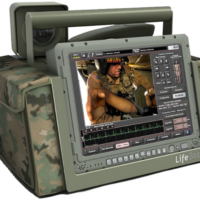Telemetry Systems & Equipment
Telemetry is an umbrella term for the process by which specific technical information is taken from one location and transmitted to another. The process has relevance for military platforms like ships, vehicles, aircraft and weapons.
Sensors maybe placed around these to provide specific information on what is happening in a particular place at a particular time. For example, an armoured vehicle may have temperature sensors in its engine, mechanical and electrical systems. These transmit temperature details to the vehicle’s central computer which continually monitors these temperatures. So long as temperatures fall within accepted thresholds for safe, efficient and reliable operation the computer stays silent. If temperatures rise and fall beyond these thresholds, the vehicle’s driver and occupants maybe alerted that something is wrong. The computer may advise them which system is at fault and how to remedy the problem. Likewise, sensors on the vehicle’s armament may record how many rounds the main gun has expended. The vehicle’s computer may store this information reminding the crew that a certain number of rounds must be replenished.
Telemetric information is increasing transmitted to off-board locations. Taking our example above, the computer may automatically send data regarding vehicle system temperatures to maintainers. Similarly, information on expended rounds maybe shared with logisticians back at base. Maintainers can be alerted to this in real time should temperature readings indicate that specific systems are performing incorrectly. They can have replacement parts and prepare processes to undertake repairs after the mission. Collection of telemetric data greatly improves the efficiency of military Maintenance, Repair and Overhaul (MRO). Logisticians can receive information on how many rounds the vehicle expends during its mission with replacement ordnance ready for when the vehicle returns to base.
Background
Telemetry is not a new science. During the industrial revolution engineers devised means to remotely monitor the performance of steam engines. This was done by mechanically connecting the engines with steam pressure gauges and other controls that could be view remotely. The advent of the telegraph from the 1840s added an additional conduit by which machines could be monitored at distance. However, it was the proliferation of radio in the early 20th Century which revolutionised telemetry. As radio is wireless, anything carrying one does not need to be physically connected to the destination of that radio’s signals.
The arrival of the space age in the 1950s saw telemetry advance further. It was imperative that engineers and scientists back on Earth could continually monitor the performance of space craft during their flight. Sensors withstanding the rigours of spaceflight were positioned onboard. These sensors collected a myriad of data on all aspects of the spacecraft’s performance transmitting the information back to Earth by radio. Telemetry proved invaluable when humans began regular spaceflights in the early 1960s. Data on an astronaut’s health could be continually collected and sent back to Earth so that their physical condition could be monitored.
Today, telemetry is routinely used by airlines to monitor the performance of their aircraft. Formula 1 cars continually gather and share telemetric data with pit crews. It is even used to monitor wildlife. Animals are fitted with telemetric tags to share information on their activity, movement and environment.
Internet of Military Things
Military telemetry use will increase in the future. The so-called ‘Internet of Military Things’ will see the unprecedented connection of platforms, sensors, weapons and personnel. These will continually share data relating to mission and condition. Communications conduits for this ensuing abundance of information will include emerging fifth-generation cellular networks. Everything from a soldier’s heartbeat to the second-by-second oil consumption of a frigate will be collected and shared. Artificial intelligence will help sort, manage and prioritise these data. This information will be used to enhance the efficacy and reduce the costs of military MRO and logistics while improving peacetime and wartime situational awareness.














